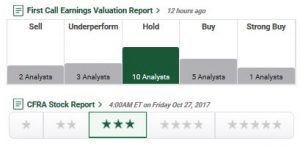Contents
 Summary
Summary
- On October 27th Exxon Mobil reported estimated Q3 results of $4B ($0.93/diluted share) versus $2.7B a year earlier.
- YTD cash flow from normal business operations plus $1.7B of asset sales has enabled XOM to support its distributions and funds investments.
- Investors are wise to hold some oil & gas stocks in their portfolio despite the cyclical nature of the industry. XOM is arguably the safest investment in this space.
- Given the cyclical nature of the oil & gas industry and XOM’s current lofty valuation, investors would be wise to make any immediate share purchase on a small scale and to acquire additional shares when XOM’s price retraces to the mid $70s or below.
Introduction
On October 27, 2017 Exxon Mobil (NYSE: XOM) released its Q3 results.
Shares are held in the FFJ Portfolio and in retirement accounts. Even though XOM operates in a very dynamic industry, I view it as a company which is positioned to succeed in most environments.
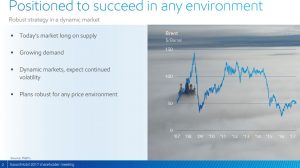
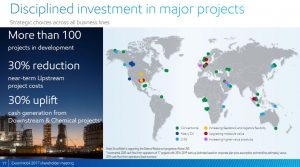 Source: XOM 2017 AGM Presentation
Source: XOM 2017 AGM Presentation
This is why I don’t pay much attention to XOM’s short-term performance and I very rarely look at its stock price. Frankly, this is probably the best thing I can do as I suspect I could really mess things up if I were to micro manage our investments.
Business Overview
You are undoubtedly familiar to some extent with XOM. The company operates in just about every corner of the globe and it ranks almost at the top of the list of Fortune 500 companies on the basis of annual revenue.
The list of XOM’s business lines is impressive. Aviation Fuels and Lubricants? They’re in that business. White Oils? Asphalt? They’re in those business lines too. It is hard to imagine how any consumer in the developed economies may have never purchased a XOM product.
I hear and read opinions about how oil and gas companies are going to be displaced as electric vehicles increase in popularity. I am not quite sure how people arrive as such a wild deduction but everyone has the right to their opinion.
I recognize readers would not expect anything other than a positive outlook from an oil and gas behemoth. Some might go so far as to suspect long-term forecasts are purposely being “doctored”. I don’t fall in the group. The reason for my line of thinking is that the XOM of 2017 is very different from the XOM of the past. It is not engaged solely in the business of finding and processing energy sources that are harmful to the environment.
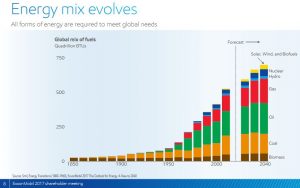
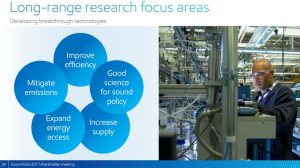
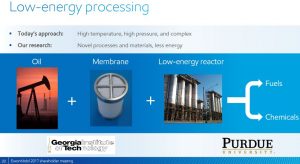
 Source: XOM 2017 AGM Presentation
Source: XOM 2017 AGM Presentation
XOM spends an inordinate amount of time and money identifying trends as part of its business planning process. It has to. You don’t spend billions of dollars looking for new reserves and on major projects or spend $1B/year in R&D across business lines unless you conduct in depth studies on environmental, technological, demographic, and economic trends.
Some people are of the opinion electric vehicles will displace gas and diesel powered vehicles. Such might be the case in the distant but you have to wonder what percentage of the global population will be able to afford electric vehicles. Unless the technology used in electric vehicles improves considerably and the global infrastructure is in place for the use of electric vehicles everywhere on this planet, I suspect gas powered vehicles will be around for many years to come. Furthermore, XOM’s products are not used solely by gas powered vehicles as evidenced by the business lines for which a link was previously provided.
XOM’s findings suggest that world population will approach 9.1 billion by 2040 which is a dramatic increase from the current 7.3 billion. Global GDP over this same timeframe is projected to double; non-member countries of the Organisation of Economic Co-Operation and Development (OECD) are expected to continue experience high levels of economic growth. In essence, rising living standards throughout most of the world will allow billions of people joining the global middle class.
How will this impact XOM? Well, economic expansion will help drive up global energy demand by about 25% by 2040. This is almost like adding another North America and Latin America to the world’s current energy demand.
Q3 and Fiscal 2017 Financial Results
XOM reported Q3 and YTD 2017 results on October 27, 2017. Readers are strongly encouraged to review the presentation which accompanied the Q3 conference call; it can be accessed here.
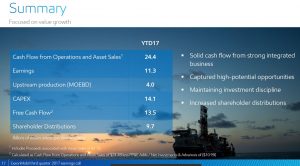 Source: Q3 2017 XOM Earnings Call - October 27, 2017
Source: Q3 2017 XOM Earnings Call - October 27, 2017
While investors are interested in the overall results, many are particularly sensitive to the number of outstanding shares. I, therefore, I draw particular attention to management’s comment regarding share repurchases.
“During the first nine months of 2017, Exxon Mobil Corporation purchased 6 million shares of its common stock for the treasury at a gross cost of $0.496B. These shares were acquired to offset dilution in conjunction with the company’s benefit plans and programs. The corporation will continue to acquire shares to offset dilution in conjunction with its benefit plans and programs, but does not currently plan on making purchases to reduce shares outstanding. The company also issued a combined 96 million shares of common stock during the first quarter to complete the acquisition of InterOil Corporation and the acquisition of entities that own oil and gas properties located primarily in the Permian Basin.”
Source: XOM October 27, 2017 News Release
Dividend, Dividend Yield, and Dividend Payout Ratio
XOM’s dividend track record can be found here. Despite the challenging environment over the past couple of years, XOM has kept its annual dividend increase record intact; the last time it froze its dividend was in 1981 - 1982.
Readers seeking to invest in a company with a relatively secure dividend and with a track record of annual growth will take comfort in knowing that XOM’s dividend payments to shareholders have grown at an average annual rate of 6.3% over the last 35 years.
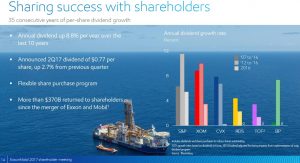 Source: XOM 2017 AGM Presentation
Source: XOM 2017 AGM Presentation
XOM’s current dividend yield is 3.68%. This is higher than the dividend yield over the past ~10 years with the exception of FY2015 when the dividend yield was comparable to the current yield. The dividend payout ratio, however, exceeds earnings per share. This is typically not sustainable unless a company divests itself of assets. This is exactly what XOM has done.
YTD 2017 cash flow exceeds dividends and net investments. This is because XOM defines cash flow as being cash flow from operations and asset sales and net investments as being additions to property, plant, and equipment and net investments/advances.
While the annual dividends disbursed by XOM exceeds cash generated from normal business operations, I view the need to sell assets to service obligations as being a normal part of this cyclical business. Typically, when this industry is performing well, FCF gushes in. When this industry hits a rough patch, FCF drops dramatically and asset sales are necessary.
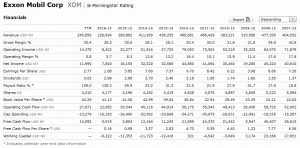 Source: Morningstar
Source: Morningstar
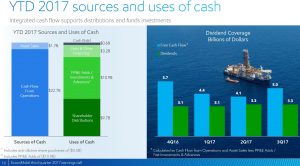 Source: Q3 2017 XOM Earnings Call - October 27, 2017
Source: Q3 2017 XOM Earnings Call - October 27, 2017
Valuation
Consensus expectation from 24 brokers is for $3.49 FY2017 EPS. Based on the current price of $83.71 (close of business October 27, 2017) we arrive at a PE of ~24. This is much higher than historical levels.
I view XOM as fully priced and it appears my opinion is backed by several analysts who have provided a HOLD rating.
Exxon Mobil - Final Thoughts
I view XOM as a core holding and it is included in my FFJ Master Stock List.
XOM operates in a cyclical business which can be cause for concern to investors with a low tolerance for risk. I can appreciate why some investors might be concerned but, in my opinion, XOM has a good handle on how to manage its risks so that it will not give shareholders a nasty “dividend cut” surprise; a list of XOM’s competitive advantages which might alleviate some concerns can be found here.
Sure, XOM is either headquartered or has operations in countries where political leaders are not playing with a “full deck”. What XOM offers, however, is that it has had to contend with this challenge for years and has thrived.
In my opinion, XOM is currently not on sale but is worthy of acquiring even at current levels. Just be conservative in the number of shares you purchase. If/when XOM’s stock price retraces to more reasonable levels (mid $70s or below) then you can “back up the truck”.
For those who acquired XOM shares in mid-2014, don’t despair. Continue to collect and automatically reinvest your dividends (assuming you do not need the money) and average down.
On a final note, treat XOM as a long-term investment. Be prepared to hold the shares through multiple economic cycles.
I wish you much success on your journey to financial freedom.
Thanks for reading!
Note: I sincerely appreciate the time you took to read this post. As always, please leave any feedback and questions you may have in the “Contact Me Here” section to the right.
Disclaimer: I have no knowledge of your individual circumstances and am not providing individualized advice or recommendations. I encourage you not to make any investment decision without conducting your own research and due diligence. You should also consult your financial advisor about your specific situation.
Disclosure: I and long XOM.
I wrote this article myself and it expresses my own opinions. I am not receiving compensation for it and have no business relationship with any company whose stock is mentioned in this article.



